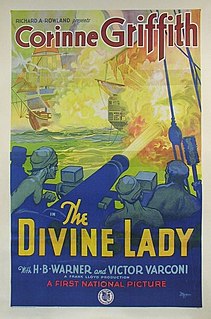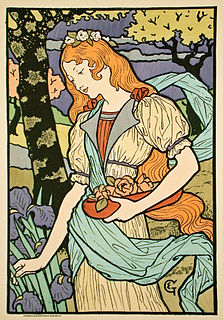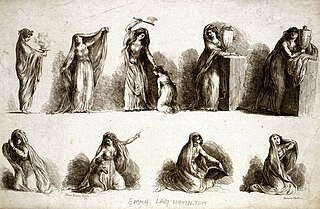
In European academic traditions, fine art is art developed primarily for aesthetics or beauty, distinguishing it from decorative art or applied art, which also has to serve some practical function, such as pottery or most metalwork. In the aesthetic theories developed in the Italian Renaissance, the highest art was that which allowed the full expression and display of the artist's imagination, unrestricted by any of the practical considerations involved in, say, making and decorating a teapot. It was also considered important that making the artwork did not involve dividing the work between different individuals with specialized skills, as might be necessary with a piece of furniture, for example. Even within the fine arts, there was a hierarchy of genres based on the amount of creative imagination required, with history painting placed higher than still life.

The Divine Lady is a 1929 American Vitaphone sound film with a synchronized musical score, sound effects, and some synchronized singing, but no spoken dialogue. It stars Corinne Griffith and tells the story of the love affair between Horatio Nelson and Emma Hamilton. It featured the theme song "Lady Divine", with lyrics by Richard Kountz and music by Nathaniel Shilkret, which became a popular hit in 1929 and was recorded by numerous artists, such as Shilkret, Frank Munn, Ben Selvin, Smith Ballew, Adrian Schubert, Sam Lanin, and Bob Haring.

Neoclassicism was a Western cultural movement in the decorative and visual arts, literature, theatre, music, and architecture that drew inspiration from the art and culture of classical antiquity. Neoclassicism was born in Rome largely thanks to the writings of Johann Joachim Winckelmann, at the time of the rediscovery of Pompeii and Herculaneum, but its popularity spread all over Europe as a generation of European art students finished their Grand Tour and returned from Italy to their home countries with newly rediscovered Greco-Roman ideals. The main Neoclassical movement coincided with the 18th-century Age of Enlightenment, and continued into the early 19th century, laterally competing with Romanticism. In architecture, the style continued throughout the 19th, 20th and up to the 21st century.

Anders Leonard Zorn was one of Sweden's foremost artists. He obtained international success as a painter, sculptor, and etcher.

Emma, Lady Hamilton was an English maid, model, dancer and actress. She began her career in London's demi-monde, becoming the mistress of a series of wealthy men, culminating in the naval hero Lord Nelson, and was the favourite model of the portrait artist George Romney.
A box set or boxed set is a set of items traditionally packaged in a box and is offered for sale as a single unit.

Sir William Hamilton,, was a British diplomat, antiquarian, archaeologist and vulcanologist. After a short period as a Member of Parliament, he served as British Ambassador to the Kingdom of Naples from 1764 to 1800. He studied the volcanoes Vesuvius and Etna, becoming a Fellow of the Royal Society and recipient of the Copley Medal. His second wife was Emma Hamilton, famed as Horatio Nelson's mistress.

Objet d'art literally means "art object" in French, but in practice, the term has long been reserved in English to describe works of art that are not paintings, large or medium-sized sculptures, prints, or drawings. It therefore covers a wide range of works, usually small and three-dimensional, of high quality and finish in areas of the decorative arts, such as metalwork items, with or without enamel, small carvings, statuettes and plaquettes in any material, including engraved gems, hardstone carvings, ivory carvings and similar items, non-utilitarian porcelain and glass, and a vast range of objects that would also be classed as antiques, such as small clocks, watches, gold boxes, and sometimes textiles, especially tapestries. Books with fine bookbindings might be included.

George Romney was an English portrait painter. He was the most fashionable artist of his day, painting many leading society figures – including his artistic muse, Emma Hamilton, mistress of Lord Nelson.
Frank Nuovo, an Italian American, has been a leading mobile phone industrial designer, and a former Vice President and Chief of Design at Nokia.

That Hamilton Woman, also known as Lady Hamilton, is a 1941 black-and-white historical film drama, produced and directed by Alexander Korda for his British company during his exile in the United States. Set during the Napoleonic Wars, the film tells the story of the rise and fall of Emma Hamilton, dance-hall girl and courtesan, who married Sir William Hamilton, British ambassador to the Kingdom of Naples. She later became mistress to Admiral Horatio Nelson. The film was a critical and financial success, and while on the surface the plot is both a war story and a romance set in Napoleonic times, it was also intended to function as a deliberately pro-British film that would portray Britain positively within the context of World War II which was being fought at that time. At the time the film was released France, Belgium, the Netherlands, Norway, Poland and Denmark had all surrendered to the Nazis and the Soviet Union was still officially allied to them, correspondingly the British were fighting against the Nazis alone and felt the need to produce films that would both boost their own morale, and also portray them sympathetically to the foreign world, and in particular, to the United States.

Charles Francis Greville PC FRS FRSE FLS FSA was a British antiquarian, collector and politician who sat in the House of Commons from 1774 to 1790.
Silver standards refer to the standards of millesimal fineness for the silver alloy used in the manufacture or crafting of silver objects. This list is organized from highest to lowest millesimal fineness, or purity of the silver.

The Art Gallery of Hamilton (AGH) is an art museum located in Hamilton, Ontario, Canada. The museum occupies a 7,000 square metres (75,000 sq ft) building on King Street West in downtown Hamilton, designed by Trevor P. Garwood-Jones. The institution is southwestern Ontario's largest and oldest art museum.

Kenneth Hayes Miller was an American painter, printmaker, and teacher.

The Grafton Galleries, often referred to as the Grafton Gallery, was an art gallery in Mayfair, London. The French art dealer Paul Durand-Ruel showed the first major exhibition in Britain of Impressionist paintings there in 1905. Roger Fry's two famous exhibitions of Post-Impressionist works in 1910 and 1912 were both held at the gallery.

Mimoplastic art is a performance art genre depicting works of art by use of mime, especially gestures and draping. Mimoplastic "attitude" is differentiated from the tableau vivant by its imitation of classical sculpture. The genre depicted works of art, particularly classical subjects.
Arthur William Brown (1881–1966) was a Canadian commercial artist, most known for his work as an illustrator for the Saturday Evening Post, American Magazine, and Redbook.
USC Fisher Museum of Art, formerly USC Fisher Gallery, which is affiliated with the University of Southern California, is the first art museum established in the city of Los Angeles. Founded in 1939 by Elizabeth Holmes Fisher, she donated 29 paintings at the beginning. When she died in 1955, the collection had grown to 74 paintings, drawings and sculptures by European and North American artists. In 1955, Armand Hammer donated to the museum a collection of 48 works by Dutch, Flemish, German, and Italian masters of the fifteenth through seventeenth centuries. In recent years, the 20th and 21st centuries collections are growing fast, not only in size, but in scope. The later collections span the medias of painting, prints, drawings, photography, and sculpture.

Expulsion from the Garden of Eden was painted in 1828 by English-born American painter Thomas Cole. It belongs to the collection of the Museum of Fine Arts, Boston and is on display in their Waleska Evans James Gallery. This landscape painting exemplifies the style of the Hudson River School, which was a group of American landscape painters that Thomas Cole is credited with founding. On the lower left part of the cliff, Cole signed his name as "T Cole".














